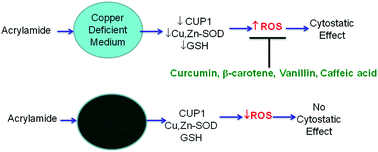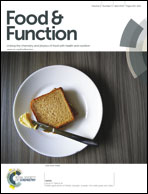Effect of dietary antioxidants on the cytostatic effect of acrylamide during copper-deficiency in Saccharomyces cerevisiae
Abstract
Acrylamide exposure increases oxidative stress and causes cytotoxicity. In order to understand the role of oxidative stress in acrylamide toxicity, we utilized Saccharomyces cerevisiae as a model organism grown in Yeast Peptone Dextrose (YPD) or Copper-Deficient Medium (CDM). Although the growth curves of yeast were comparable in these media, acrylamide treatment resulted in significant growth inhibition and colony formation only in the CDM. Copper-deficiency induced a decrease in the intracellular metallothionein levels, along with reduced Cu, Zn-SOD activity that appeared to increase the sensitivity of the yeast to the cytostatic effect of acrylamide. Increased dichlorofluorescein (DCF) fluorescence, enhanced formation of para-phenyl tertiary butyl nitrone (PBN)–hydroxyethyl adducts and a lowered reduced glutathione (GSH) content were observed under copper-deficient conditions, when challenged with acrylamide. The cytostatic effects and intracellular redox changes in response to acrylamide were ameliorated by antioxidant molecules viz. a viz. curcumin, β-carotene, vanillin and caffeic acid, which effectively decreased the oxidative stress and improved the growth recovery.


 Please wait while we load your content...
Please wait while we load your content...